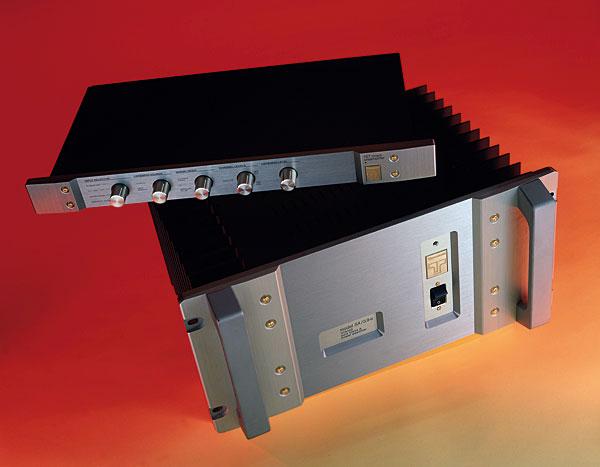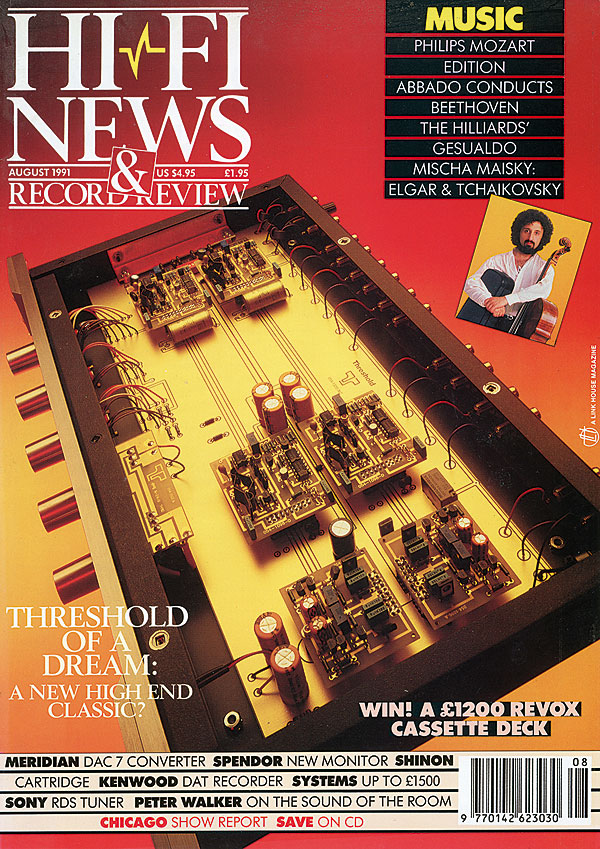Threshold pre/power

 Martin Colloms hears the FET nine/e and SA/3.9e from Threshold – a company that can lay claim to being one of the founders of the high-end...
Martin Colloms hears the FET nine/e and SA/3.9e from Threshold – a company that can lay claim to being one of the founders of the high-end...
Threshold has been making high-quality amps for many years, its preamps showing early use of FET circuitry and the power amps distinguished by an output stage design which Threshold calls 'Stasis', a kind of active Class A operation. Company founder and chief designer, Nelson Pass, remains fully involved and his signature appears on the circuit diagrams included in the excellently documented operating manuals supplied with the units.
Threshold is not a large concern, but a modular approach to design has spawned a wide range of power amps in the SA or Stasis series. There are five, ranging from the SA/3.9e tested here at 60W/channel to the '4, '6, '10 and '12, the latter being a 250W-per-channel behemoth.
Below the SA series come the four 's' models, which have a lower standing-current and offer 150W for the '350, up to the '1600 monoblock with 750W. One might well think that there are too many models here, but the modular build allows for the same basic design to serve an ever-increasing array of heatsink-mounted transistors and larger power supplies.

Double Bind
Presented with a massive anodised alloy fascia finished in silver grey, the SA/3.9e has the usual handles, a necessity in view of its substantial 25kg. Its single control is a circuit-breaker type power switch, inrush current protected, and the unit requires a total depth of 35.5cm. Line input is 600ohm loaded XLR balanced, or 47kohm unbalanced via phono sockets. Loudspeaker connection is less friendly, via single pairs of massive insulated binding posts with cramped access for tightening. These will only accept properly made spade terminals so bare wire and banana plugs are out.
Complementing the power amp is the FET nine.e preamp – a slim unit at just over 5.5cm high. One could not expect the power supply to be incorporated, and this is located in a separate box linked by a generous detachable umbilical. The preamp has facilities for medium-to-high output MC and MM cartridges, with versatile input matching options selected via a DIL switch located under the top cover. Input resistance options include 32, 47, 100ohm and 47kohms, plus 50, 100, 200 or 250pF of parallel capacitance.
The FET nine.e preamp is single-ended throughout, absolute-phase correct, and its inputs and outputs are in gold-plated phono sockets. In addition to analogue disc there are inputs for CD, tuner, and TV audio/aux plus one tape recorder loop. Separate balance and volume controls are provided and the mode switch offers mono, stereo and 20dB muting.

Design And Technology
The power amplifier employs a compound output stage without overall feedback to the input and driver circuitry. A low-output impedance is defined by its own short internal feedback loop and the large number of parallel output devices operating in highly linear, semi-Class A mode, biased to a standing current of 2A. This allows for a fine Class A output of 16W.
I dispute Threshold's qualified claims for Class A operation. For a start, the heatsinks would need to be double the size and run much hotter. In the case of the SA/3.9e my interpretation is that it is truly Class A to within 6dB of full power, that last range being 'A/B'. Stereo operation involves a form of dynamic biasing of the output stage, in this case achieved via an opto-coupler. Twelve 250W, 20A output devices are used per channel, TO3 metal-can transistors in a complementary configuration. The amplifier is non-inverting and is DC-coupled with no servo.
Output protection is limited to rail fuses, and a spurious DC output could easily blow a bass unit before the fuses go. No output relay is provided. At the input there is a differential cascode based on J-FETs. The circuit is straightforward aside from the offset correction system, which is also opto-coupled. The single-ended voltage amplifier is improved by a cascode transistor and a constant-current load.

On The Cards
Even in the main sector negative feedback is held to 'just a few dB', according to Threshold. A single heavy-duty low-hum toroidal transformer powers the unit, but separate rectifiers and reservoir capacitors feed each channel. As for standards of construction, these are excellent, with gold-on-nickel circuitboard tracks used.
Inside the preamp, meanwhile, can be found a large double-sided gold-plated motherboard carrying the main signal tracks and power lines. The active sections, divided into mono units, are built as plug-in modules with an option for further upgrading. The power-supply cards comprise discrete regulators, while the four audio sections are all the same. Gain loading and equalisation parameters are set on the connection to the motherboard. Cables are looped through ferrite rings to block RFI, with such a ring also present on the power cable.
The basic circuit is a high-linearity, medium-power op-amp assembled with discrete devices, DC-coupled with servo control. The input comprises two sets of differential J-FETs parallelled to reduce input noise, together with a cascode FET voltage amplifier. The output is complementary bipolar, working in Class A. Build quality and service accessibility are very good.


















































